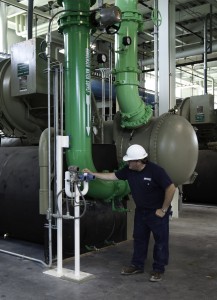 Commissioning is a process that provides a range of benefits for both building owners and facility managers, not the least of which is verifying that a building’s systems work the way they’re supposed to in accordance with the owner’s requirements. Commissioning provides opportunities to enhance system performance, lower operational costs and increase comfort for occupants, all with the goal of increased efficiency. The result is a facility that’s more reliable, easier to manage and less costly. If you’re a facility manager, here are three reasons you should make sure that commissioning is on your radar screen.
Commissioning is a process that provides a range of benefits for both building owners and facility managers, not the least of which is verifying that a building’s systems work the way they’re supposed to in accordance with the owner’s requirements. Commissioning provides opportunities to enhance system performance, lower operational costs and increase comfort for occupants, all with the goal of increased efficiency. The result is a facility that’s more reliable, easier to manage and less costly. If you’re a facility manager, here are three reasons you should make sure that commissioning is on your radar screen.
Core competencies
Building commissioning addresses core competencies identified by the International Facility Management Association (IFMA) including communication, emergency preparedness, environmental stewardship and sustainability, finance and business, human factors, operations and maintenance, quality, and technology. The commissioning process addresses each of these competencies and streamlines them to benefit the facility manager.
Competitive advantage
Commissioning gives facility managers a competitive advantage because the reduced cost of building operation leaves more resources available to be invested. The increased performance of building systems reduces the number of time-consuming and costly repairs and replacements that need to be made over time, and the increased comfort leads to greater productivity and happiness for building occupants, making those buildings more attractive to prospective tenants. A commissioning study conducted in 2009 by the Lawrence Berkeley National Laboratory found that “… commissioning is one of the most cost-effective means of improving energy efficiency in commercial buildings.”
Collaborative approach
Commissioning builds a bridge of communication that extends throughout the life cycle of the facility. This leads to integration of both the people and processes involved in delivering an owner a facility that not only functions optimally, it also serves as a strategic resource. Commissioning unites all stakeholders — the design team, the construction team and the maintenance team — and allows a facility manager to benefit from streamlined communications and integrated, cohesive operations among all team members.
Want to know more? The U.S. General Services Administration is a great resource for additional information on the commissioning process. You can find a link to their website at the end of this post. If you’d like to know more about the commissioning process and how it may be beneficial for you and your facilities, send me an email or connect with me on LinkedIn.
Brian Lindstrom, PE, DCEP, is the national director of commissioning at Burns & McDonnell. He has been responsible for commissioning exceeding $8 billion and 19 million square feet of new construction, and retro-commissioning exceeding 10 million square feet of existing facility space.
More resources on this topic:
U.S. General Services Administration website
Building Commissioning Association website
American Society of Heating, Refrigerating and Air Conditioning Engineers website
